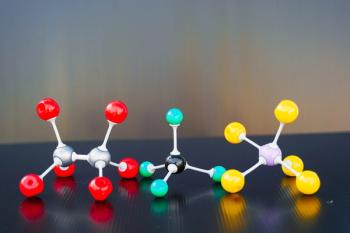
- The Application Notebook-09-02-2015
- Issue 0
Detection of Chiral Drugs Using HPLC with CD Detection
The need for chiral detection in the development of pharmaceuticals is increasing due to regulatory changes and the demand for single-isomer pharmaceutical drugs
The need for chiral detection in the development of pharmaceuticals is increasing due to regulatory changes and the demand for single-isomer pharmaceutical drugs. These shifts require a means for chiral detection and compound separation because there is little control over which chiral form of a chemical compound is formed during the drug's production. At the molecular level chiral partners have identical physical properties and therefore are very difficult and expensive to separate.
Both Prilosec (omeprazole) and Nexium (esomeprazole) are proton pump inhibitors used to treat ulcers, heartburn, acid reflux, and Zollinger-Ellison syndrome. Nexium's active ingredient, esomeprazole, is the S-enantiomer of omeprazole, the active ingredient in Prilosec. Nexium was one of the first pharmaceuticals to be repatented and marketed as a pure enantiomer of a formerly mixed enantiomer drug. Nexium has a superior clinical efficacy due to its higher and more consistent bioavailability. We aimed to test the enantiomeric purity of both drugs using an HPLC system with circular dichroism (CD), fluorescence (FP), and optical rotation (OR) detectors.
Experimental Conditions
Prescription Nexium and Prilosec were examined by grinding the tablets and dissolving them in ethanol, and sonicating for 20 min. These solutions were brought to a final concentration of 1 µg/µL with an injection size of 2 µL. Separations were accomplished using a ChiralPak AD column (4.6 × 250 mm) with a 100% EtOH mobile phase and a flow rate of 0.9 mL/min. A JASCO HPLC system with CD, OR and FP detectors was used to perform the analysis.
Figure 1: Prilosec chromatograms Top: CD detector / Middle: FP detector / Bottom: OR detector.
Results and Discussion
The Nexium and Prilosec chromatograms are shown in Figures 1 and 2. As expected, the Prilosec chromatograms showed the inclusion of both enantiomers while in the Nexium results only the esomeprazole enantiomer was detected.
Figure 2: Nexium chromatograms Top: CD detector / Middle: FP detector / Bottom: OR detector
The results are clearest in the CD chromatograms. While the FP detector was as sensitive as the CD detector with respect to concentration, it was not able to clearly identify which enantiomer was which. On the other hand, while the OR detector was capable of discriminating the enantiomers, it was far less sensitive than the CD detector with respect to concentration.
Conclusion
An HPLC system outfitted with a CD detector is able to effectively determine the enantiomeric purity of certain chiral drugs more effectively than similar systems with either FP or OR detectors. JASCO currently offers the world's only CD detector for HPLC.
JASCO, Inc.
28600 Mary's Court, Easton, MD 21601
tel. (800) 333-5272, fax (410) 822-7526
Website:
Articles in this issue
over 10 years ago
Characteristics and Application of a Chiral Column, Chiral CD-Phover 10 years ago
An Automated Extraction Solutionover 10 years ago
Hexavalent Chromium Determination Hamiltonover 10 years ago
A New HILIC Column for Saccharide AnalysisNewsletter
Join the global community of analytical scientists who trust LCGC for insights on the latest techniques, trends, and expert solutions in chromatography.




